Herons and Co.
Herons and egrets wading in local wetlands or silhouetted against blue skies, excite people whenever they are seen. They speak to us of grace, elegance and regal bearing. We would do well to listen to what they have to say.
The muskrat landed with a “thud” a pace or two from where I stood. Spat up from the gullet of a heron on high, it now lay in peaceful repose on the forest floor. The muskrat was not fully grown, but it was still a substantial animal. I pondered the implications.
I marvelled at the obvious elastic capabilities of a great blue heron’s throat. The muskrat had been swallowed whole for heaven’s sake! I wondered at the struggle between bird and mammal that must have ensued prior to the final gulp. And I soberly considered that the partially digested muskrat could have hit me or one of my companions.

The great blue heron’s flight suggests that of a pterodactyl over a steaming Jurassic swamp. Photo by Ron Pitts.
At the time of the incident, I was counting great blue heron nests at a breeding colony or “heronry.” Heronries can contain dozens or even hundreds of large stick nests perched high above the ground in mature deciduous trees. The plummeting muskrat was no accident. Regurgitating food and dropping it in the direction of potential predators is a typical heron stress response. Perhaps such behaviour evolved to warn off predators, or perhaps the food could be seen as an offering: “Here, take this and go away!”

As dusk falls on the heronry, parents settle in to roost on their nests of rough sticks. Photo by Ron Pitts.
The regurgitated food, and the excrement, euphemistically known as “whitewash,” that gets sprayed in the course of regular hygiene from nests to the woodland floor, lends a rather ripe ambiance to an active heronry. The sound of a heronry is also notable. Multiply each nest by three or four young, all squabbling like drunken bar patrons when their parents return with food, and you have a cacophony that disturbs the usual woodland idyll.
Before I go any further I should note that a casual visit to a heronry during the breeding season is not a good idea. Herons are easily spooked. Regurgitated food is nutrition lost to the growing young. Trespassing can flush adults from the nests, leaving vulnerable eggs or fledglings to the mercies of the weather or to marauding scavengers like crows and ravens. Repeated visits can even cause colony abandonment.
The protection of heronries is one reason the Grand River Conservation Authority prohibits boating in Luther Marsh, where a great blue heron colony is located, prior to August 1.
So what was my excuse? At the time I was participating in the Ontario Heronry Inventory, a project of Bird Studies Canada to monitor trends in great blue heron populations throughout Ontario. Brief visits to the heronries were considered acceptable.
While great blue herons forage throughout the entirety of the Headwaters region, their heronries are far more localized. Luther Marsh, the glorious waterfowl nursery straddling the borders of Dufferin and Wellington counties, is one location. Perhaps the largest though, is at Albion Hills Conservation Area.
In November last year, I counted eighty nests perched in beech, sugar maple, white ash and basswood trees at Albion Hills. A single beech held eight nests, another held six and a large sugar maple supported five. From this colony great blue herons fan out to forage at the numerous kettle lakes that spangle the Oak Ridges Moraine.
Karen McDonald of the Toronto Region Conservation Authority says that “the number of nests at Albion Hills has been steadily expanding over the past four years.” This is good news for our local herons, but the news from the province as a whole is less positive. The second Breeding Bird Atlas of Ontario (2007) shows the great blue heron population has been in decline since the early 1980s when the first atlas was completed. While there is some uncertainty as to the causes and magnitude of this decline, fewer frogs, a heron staple, may be a factor. Further study of both heron and frog populations may provide some answers.
It appears that for now at least, this area, richly endowed with ponds, swamps and streams, continues to offer great blue herons the choice aquatic edibles they covet. It is a safe bet that any local pond, stream or marsh harbouring fish or frogs is visited regularly by these birds. They are often seen wading silently or flying methodically overhead. This flight between their heronries and favoured fishing holes is far more direct than that of easily distracted crows. “As the heron flies” would better indicate the shortest distance between two points than “as the crow flies.”
Tip to tip, the wings that power a great blue heron’s f light match the arm span of an average human adult. A heron carried aloft on these wide wings imaginatively suggests the flight of a pterodactyl over a steaming Jurassic swamp, an illusion enhanced by the heron’s voice, a prehistoric-sounding “croak.”
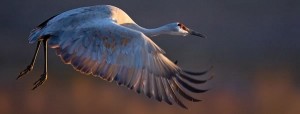
Sandhill cranes are similar in size and colour to great blue herons, but fly with their neck fully extended. They are recent immigrants to the hills. Photo by Ron Pitts.
Great blue herons are often mistakenly called “cranes.” True cranes are an unrelated group of wading birds that includes the storied whooping crane, a magnificent and endangered bird rescued from the brink of extinction by intensive conservation efforts in the United States and Canada. There are no whooping cranes in our region, but there are now sandhill cranes, close kin.
Sandhill cranes have swept down from Ontario’s northwest into southern Ontario over the last few decades. Similar in size and colour to great blue herons, small numbers of them now nest at Luther Marsh. If you look up to see a large grey bird flying overhead, watch how it holds its neck. If the neck is folded back in an “s” shape you have spotted the far more common great blue heron. However, if the neck is fully extended, you can welcome a recent immigrant to Headwaters, a sandhill crane.
While most residents of our hills have at least a passing acquaintance with great blue herons, far less familiar are the other species of herons that inhabit the hills. One of these is the great egret, a pure white heron of ethereal beauty that has inspired poets throughout the ages.
Judith Wright rhapsodized about these sublime birds in her poem, called simply “Egrets”:
Once as I travelled through a quiet evening,
I saw a pool, jet-black and mirror still.
Beyond, the slender paperbarks stood crowding;
Each on its own white image looked its fill,
and nothing moved but thirty egrets wading —
thirty egrets in a quiet evening.
Once in a lifetime, lovely past believing,
your lucky eyes may light on such a pool.
As though for many years I had been waiting,
I watched in silence, till my heart was full
of clear dark water, and white trees unmoving,
and, whiter yet, those thirty egrets wading.
The “lucky eyes” of naturalist Linda McLaren, the gifted Amaranth artist responsible for “Headwaters Sketchbook” in this magazine, have gazed more than once in her lifetime at similar scenes. For the last two years McLaren has monitored an amazing assemblage of great egrets at Luther Marsh. She told me of taking Chip Weseloh, an egret researcher with the Ministry of the Environment, to Luther two summers ago.
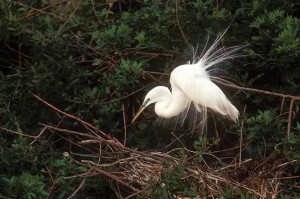
The delicate feathers of the egret were once eagerly sought by the millinery trade, a fad that led the birds to near extinction. Photo by Robert McCaw.
“On the evening in early September of 2008 when I met Chip to show him where the [egret] roost was, we counted over 200,” McLaren says. “He kept looking at them through his binoculars and saying, ‘I had no idea. I had no idea!’”
Chip Weseloh has studied great egrets for years and is one of Ontario’s foremost experts on their habits and haunts. His reaction to the Luther Marsh egrets indicates just how impressive that aggregation is. In fact, at one point late last summer, Linda McLaren counted over 300 egrets.
Of interest to Weseloh is that these egrets do not breed at Luther, but rather use it as a post-breeding roosting area. He thinks they probably migrate south to the marsh from a thriving nesting colony he studies on a Georgian Bay island near Collingwood.
For the egrets, the lure of Luther is not accommodation but the minnows and other small fi sh they can stalk easily in the extensive shallow waters. These fish, to borrow a sports term, are very underrated. We generally ignore them, but we shouldn’t. Without them the egrets – and their inspiring beauty – would not exist.
That beauty was almost their undoing a century ago. Entire colonies were “shot out” to acquire the delicate feather plumes known as “aigrettes” that decorate the backs of egrets during the breeding season. (“Aigrette” is a French word that gave rise to the name “egret.”) These plumes were eagerly sought by the millinery trade to add flourish to hats for fashionable ladies.
Herbert K. Job, an early twentieth-century writer and ornithologist, reported that at a single auction in London, England in 1902, 48,240 ounces of heron plumes from North America were sold. “As it requires about four birds to make an ounce of plumes,” he calculated, “these sales meant 192,960 herons killed at their nests, and from two to three times that number of young or eggs destroyed. Is it, then, any wonder that these species are on the verge of extinction?”
Fortunately tragedy was averted by the work of early conservationists who successfully lobbied the United States government to outlaw the plume trade. This lobbying effort gave rise to the Audubon Society, a prominent American conservation organization that adopted the great egret as its symbol.
By the time the egret slaughter ceased, only a few scattered colonies remained in the southeastern United States. It is from these outposts that great egrets advanced to recolonize the rest of the eastern United States. Then, according to Chip Weseloh, “they were found breeding in Ontario in the 1950s and their numbers have been going up gradually ever since.”
Now their expansion has embraced our region, with the aquatic richness of Luther Marsh helping to fuel their recovery. If this trend continues we can expect great egrets to appear more widely in this area. Perhaps one day soon you too will be able to thrill to the presence of egrets in a pool of “clear dark water” in your neighbourhood.
Will the egret expansion continue? Double-crested cormorants may throw up a roadblock. These large fish-eating birds compete aggressively with great egrets for nesting sites and their numbers have exploded in recent decades. Tens of thousands are now found along the shorelines of the lower Great Lakes and they are rapidly colonizing inland sites as well, including Luther Marsh.
Chip Weseloh is hopeful though: “The egrets seem to be able to figure out that they should not challenge the cormorants for nesting spots in the tops of trees,” he says. “If they nest in the lower reaches, they seem to be able to avoid conflict with cormorants.”
There is another heron that lives commonly among us in the hills, but because it lacks the flamboyance of the great egret and is much smaller than the great blue heron, it often escapes notice. It is the green heron, a crow-sized bird named for its blue-green back and upper wings.
The green heron, like its larger relatives, has a long neck tipped by a dagger beak that it can lash out, cobra-like, to catch frogs, fish and tadpoles. Often, green herons crouch motionless and wait for unsuspecting prey to swim within striking range. At other times they walk in Tai Chi motion along stream edges and pond margins, watchful for the slightest movement in the water.
These hunting strategies are common to other herons and egrets as well, but green herons have a fascinating way of feeding that is theirs alone. Last summer, while paddling a quiet stream, I rounded a bend and spotted a green heron hunched atop a log, peering down into the water. Preoccupied, it was not aware of my presence.
I watched as it dropped a twig into the stream. Before the twig drifted out of range the heron picked it up and repeated the performance. Green herons are tool users. They cast sticks, leaves, berries and other small buoyant objects into the water as lures for curious minnows.
The recent second Ontario Breeding Bird Atlas documents an alarming 29 per cent decline since the early eighties in the probability of observing green herons in the province. The causes are not yet understood. The usual suspect, habitat loss, does not appear to be one of them, for as the atlas notes, “much suitable habitat is unoccupied.” Perhaps fewer frogs, a possible cause of the decline of great blue herons, is also playing a role in the decline of green herons.
One of the rarest species of heron to occupy our region is the black-crowned night heron. This dapper bird sports a black cap and back that contrasts with grey wings and a whitish breast. During breeding season, a pair of long white plumes extends rakishly from the head along the upper back. Its red eyes glow like rubies. Fish and frogs that successfully swim the daytime gauntlet of egrets, green herons and great blues have this stalker to contend with after dark. Five-star dining for a black-crowned night heron is a clear pool of silvered minnows glinting in the moonlight.
Thirty years ago there was a colony of black-crowned night herons at Luther Marsh. In the absence of boating restrictions at that time, this heronry became a destination for canoeists and camera buffs who caused its abandonment.
“The intrusion happened before the young could fly,” says Robert Bell of the Grand River Conservation Authority. “They jumped from the nests and drowned.”
Only now are black-crowned night herons beginning to nest again at Luther Marsh. “I have observed several adults and hatching-year birds this year for the first time since I came here in 1985,” Bell reported last summer. This cautionary tale emphasizes the vulnerability of heronries to human disturbance.
If the colony of black-crowned night herons at Luther Marsh continues to grow, we may begin to see these nocturnal hunters elsewhere on our local waterways, for they travel widely in search of good eats. However, there are two other herons that live in the hills that will never be commonly observed. They are the bitterns: the American and the least. Both are marsh birds and both are camouflage experts.
The American bittern was recorded from several Headwaters’ wetlands during the second Breeding Bird Atlas project, primarily along the Niagara Escarpment and at Luther Marsh. However, it is rarely seen by chance because of its fascinating habit of pointing its bill skyward as it stands among reeds and cattails. The brown streaking on its neck and breast make it one with the vegetation.
Listening rather than looking is a better way to find this bird. American bitterns have an otherworldly call, usually heard after dark. It is described in A Field Guide to the Birds by Roger Tory Peterson as “a slow, deep oong-ka choonk, oong-ka choonk, oong-ka choonk.”
Summon your lowest bass voice from the deepest channels of your throat and you may approximate the sound. Then a nocturnal visit to Luther Marsh in springtime will offer you a chance to compare your rendition with that of an actual bittern.
If American bitterns are difficult to see, their diminutive cousins, the least bitterns, are even more so. There are dedicated bird watchers in the hills who will live out their lives without ever having one of these enigmatic birds grace their binoculars’ field of view.
Not much larger than a grackle, the aptly named “least” bittern is very rare in this region and is only reliably found, where else, but at the crucially important waterworld that is Luther Marsh. Robert Bell is sure that they breed at Luther, “but they are tricky buggers to find.”
“Tricky” understates the difficulty finding these tiny herons that seldom leave the vegetative cover of their wetland homes. The best way to locate them, like their cousin the American bittern, is to listen for their call, described in The Sibley Guide to the Birds as “a low, cooing poopoopoo.”
Herons and egrets wading in local wetlands or silhouetted against blue skies, excite people whenever they are seen. They speak to us of grace, elegance and regal bearing. But they speak to us of other things as well. Built of the fish, frogs and small mammals that wetlands support, herons are the literal embodiment of those wetlands. Healthy populations of herons tell us that our wetlands are healthy; declining numbers whisper that something has gone awry. We should listen closely to what the herons say.

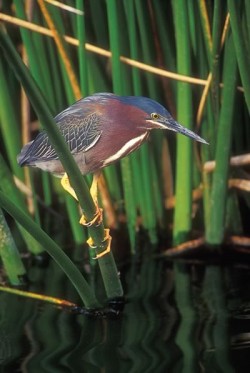
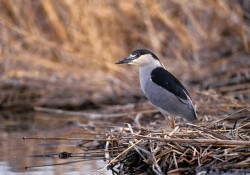
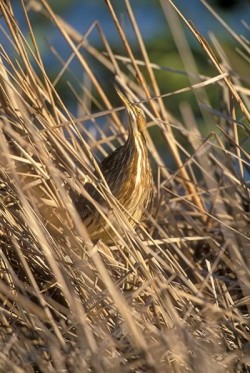
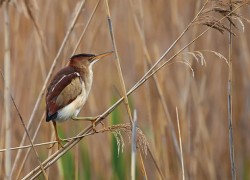






Beautifully written, Don! And I learned a few things I didn’t know, too.
Bette-Ann on Jul 29, 2010 at 12:18 am |